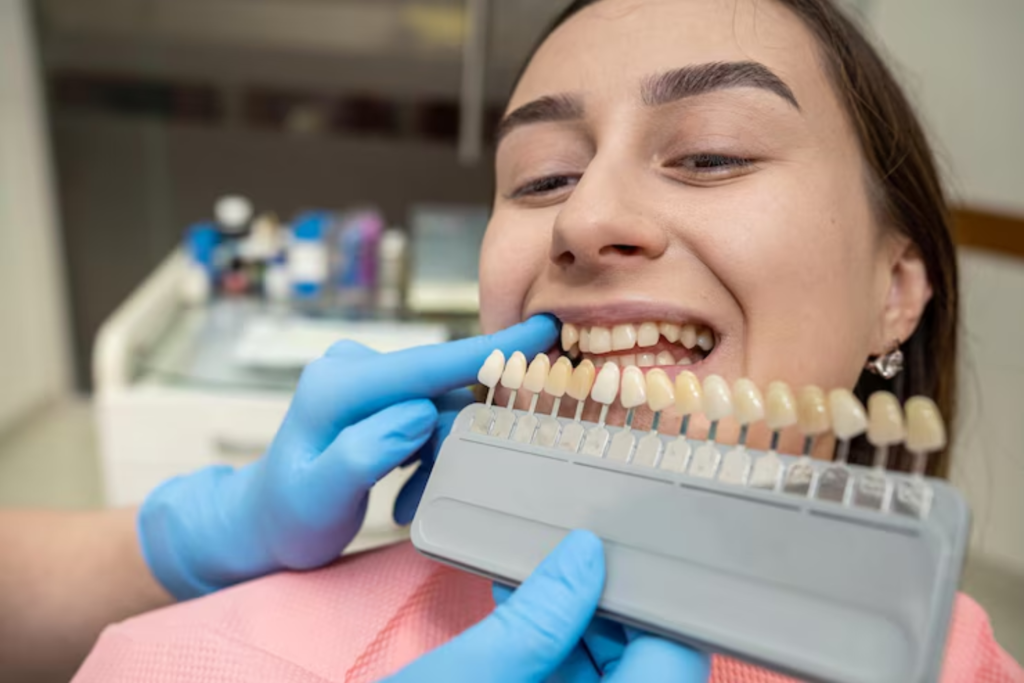Cracked chips or lingering stains hiding your smile?
Porcelain veneers offer a dazzling solution! These custom-made shells bond to the front of your teeth, masking imperfections and creating a picture-perfect grin.
But what if you already have cavities addressed with fillings? Can veneers still be placed over them?
The answer – it depends!
Veneers excel at transforming smiles with minor flaws, but their placement hinges on the condition of your existing fillings. This blog dives deep into the exciting world of porcelain veneers over fillings. We explore the possibilities, discuss crucial factors a dentist considers, and guide you toward achieving a smile that shines with confidence!
Can You Get Veneers Over Fillings? Analyzing The Options
Porcelain veneers are thin shells, typically made from durable ceramic or porcelain, that are custom-crafted to perfectly match the size, shape, and color of your natural teeth. They are bonded directly to the front surface of your teeth, effectively masking chips, cracks, discoloration, and minor misalignments. But what about teeth with existing fillings?
There are actually two options to consider:
- Veneers Over Small Fillings: If your fillings are small and located deep within the tooth structure, they might not pose a problem for veneer placement. In this case, the dentist can etch the tooth surface, including the filling area, to create a strong bond for the veneer.
- Replacing Fillings With Veneers: For larger or more noticeable fillings, especially those closer to the tooth’s surface, your dentist might recommend replacing them with the veneer itself. This ensures a uniform, flawless appearance and creates a stronger foundation for the veneer.
However, the decision to place veneers over fillings isn’t one-size-fits-all. Several factors influence a dentist’s recommendation, which we’ll explore in the next section.
Assessing Your Smile: Consultation & Planning
Before embarking on your veneer journey, a comprehensive dental consultation is crucial. This initial appointment allows your dentist to assess your candidacy for veneers and determine if they can be placed over your existing fillings. Here’s what you can expect during a consultation:
- Thorough Examination: Your dentist will meticulously examine your teeth, including a close look at your fillings. They’ll evaluate the size, location, and condition of the fillings to determine their suitability for veneers.
- X-Ray Insights: Dental X-rays provide valuable information about the underlying tooth structure and the extent of any decay beneath the fillings. This helps the dentist assess the overall health of your teeth and jawbone.
- Discussing Your Goals: An open conversation with your dentist is key. Share your aesthetic desires and concerns about your smile. This dialogue helps the dentist tailor the treatment plan to achieve your dream smile, considering the feasibility of veneers over fillings.
Preparing The Tooth For Veneers
Once the treatment plan is finalized, it’s time to prepare the tooth for the veneer. Here’s a glimpse into this process:
- Local Anesthetic: Your dentist will ensure your comfort by administering a local anesthetic to numb the area around the tooth receiving the veneer.
- Shaping and Etching: A minimal amount of enamel is carefully removed from the front surface of the tooth. This creates space for the veneer while ensuring a natural look. Additionally, the tooth surface is etched to create a roughened texture that enhances the bonding strength of the veneer.
- Taking Impressions: A precise impression of the prepared tooth is captured using a special mold. This impression acts as a blueprint for creating your custom-made veneer in the dental lab, ensuring a perfect fit and flawless aesthetics.
Can Veneers Fix Large Fillings or Decay? Considering Alternatives
While porcelain veneers offer a remarkable cosmetic solution, their application has limitations. Extensive decay or very large fillings might not be ideal candidates for veneers.
- Strength and Coverage: Veneers are designed to address aesthetic concerns, not structural weaknesses. Large cavities or significant decay can compromise the underlying tooth structure. Veneers primarily bond to the enamel, and in such cases, there might not be enough healthy tooth structure remaining for a strong, secure bond.
- Limited Coverage: Veneers typically cover the front surface of the tooth. For deep decay or damage affecting the sides or back of the tooth, veneers won’t provide sufficient coverage and protection.
However, fret not! If veneers aren’t the answer, dentistry offers another powerful tool – dental crowns.
- Crowns for the Rescue: Dental crowns are custom-made caps that completely encase the entire tooth structure. This makes them ideal for teeth with significant decay, cracks, fractures, or large fillings. Crowns provide exceptional strength, restoring the tooth’s functionality and offering excellent protection.
- Crowns: The Procedure: Placing a crown typically involves minimal tooth reduction to create a slight space for the crown. An impression is taken, and a custom-made crown is crafted from durable materials like porcelain or zirconia. The final crown is then securely cemented onto the prepared tooth, restoring both aesthetics and function.
Bonding The Veneers & Aftercare
The grand finale arrives – bonding your custom-made veneers! Here’s what to expect:
- The Perfect Fit: Your dentist will meticulously check the fit and color of the veneers, ensuring they seamlessly blend with your surrounding teeth.
- Securing Your Smile: Once everything is perfect, a special adhesive is applied to both the veneer and your tooth. The dentist might use a curing light to activate the adhesive, permanently bonding the veneer to your tooth.
Following the procedure, your dentist will provide detailed aftercare instructions to ensure the long-lasting beauty of your veneers. This typically includes:
- Dietary Adjustments: For a few days, avoid hard, sticky, or chewy foods that could potentially damage the veneers.
- Brushing and Flossing: Maintaining excellent oral hygiene is crucial. Brush twice daily and floss meticulously around the veneers to prevent plaque buildup and gum disease.

The Benefits of Veneers
Porcelain veneers go beyond aesthetics, although their transformative power is undeniable. Imagine a smile that radiates confidence with a dazzling brightness and a uniform, flawless appearance. Veneers effectively mask imperfections, creating a picture-perfect grin you’ll love to show off. But the benefits extend deeper.
- Veneers, when cared for properly, can improve your oral health by preventing further wear and tear on your teeth.
- They can also make it easier to maintain good hygiene by creating a smooth, polished surface that resists staining and plaque buildup.
- With veneers, you’ll not only look stunning, but you’ll also experience a newfound confidence in your smile and overall well-being.
Maintaining Your Veneers: Ensuring Long-Term Success
Just like your natural teeth, porcelain veneers require regular TLC to maintain their brilliance. Schedule regular dental checkups and cleanings with your dentist. These appointments allow for professional cleaning to remove plaque buildup and ensure the veneers remain securely bonded.
Maintaining excellent oral hygiene at home is equally important. Brushing twice daily with a soft-bristled brush and flossing meticulously around the veneers are key practices. With proper care, porcelain veneers can last for a decade or even longer, gracing you with a dazzling smile for years to come.
Achieving a picture-perfect smile with veneers over fillings is possible! However, consulting a dentist is crucial to determine the best course of action for your unique situation. Schedule an appointment today to discuss your dream smile and explore the possibilities with veneers!




